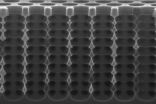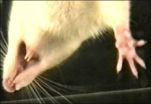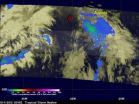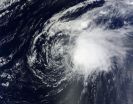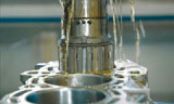(Press-News.org) This press release is available in German.
Deep below the silicon surface, the SPRIE method produces regular structures in the micrometer range that refract light. (Photo: KIT/CFN)
In modern telecommunications, light carries digital information over kilometers within seconds. Adapted optical materials control the light signals. In the AFM journal, researchers from Berlin, Louvain, and from Karlsruhe Institute of Technology present a method to produce photonic crystals. Their optical properties are adjusted by structures of micrometer size. The method is rapid, cheap, and simple and partly uses the self-organization principle (DOI: 10.1002/adfm.201201138).
"Optical properties of materials can be influenced decisively by specific structurization," explains Andreas Frölich from Karlsruhe Institute of Technology. Silicon is used in components, e.g. filters or deflectors, for telecommunications. So far, however, all these components have been flat, i.e. two-dimensional. Entirely novel concepts might be feasible using three-dimensional components. The expenditure required to structure the silicon is very high. The structure has to be very regular in all three spatial directions and details are to have the size of about one micrometer, which corresponds to one hundredth of the thickness of a hair.
"Our new SPRIE fabrication methods uses established technologies, such as etching and innovative methods like self-organization and combines them in a very creative manner," says Martin Wegener, Professor of the Institute of Applied Physics and Institute of Nano-technology of KIT and coordinator of the DFG Center for Functional Nanostructures (CFN). The SPRIE method is applied to structure silicon on large areas in a simple and three-dimensional manner. First, a solution with micrometer-sized spheres of polystyrene is applied to the silicon surface. After drying, these spheres automati-cally form in a dense monolayer on the silicon. Upon metal coating and the removal of the spheres, a honeycomb etching mask remains on the silicon surface.
"This etching mask is our two-dimensional template for the construc-tion of the three-dimensional structure," says Frölich. The free areas are removed by etching with a reactive plasma gas. An electric field is applied to make the gas particles etch into the depth only or homogeneously in all directions." In addition, we can specifically pas-sivate the walls of the hole, which means that it is protected from further etching by a polymer layer."
Repeated etching and passivation makes the holes of the etching mask grow into the depth. With up to 10 micrometers, their depth exceeds their width by a factor of more than 10. The process steps and the electric field are adjusted precisely to control the structure of the walls. Instead of a simple hole with vertical smooth walls, every etching step produces a spherical depression with a curved surface. This curvature is the basis for the regular repeating structures of novel waveguides. "Optical telecommunication takes place at a wavelength of 1.5 µm. With our etching method, we produce a cor-rugated structure in the micrometer range along the wall." The field at closely adjacent and very deep, structured holes acts like a regular crystal that refracts in the desired manner.
The SPRIE (Sequential Passivation and Reactive Ion Etching) method can produce a three-dimensional photonic crystal within a few minutes, as it is based on conventional industrial processes. In principle, a three-dimensional structure can be generated in silicon using a freely choosable mask. This opens up new possibilities for meeting the requirements made on optical components in telecommunications.
Different designs of photonic crystals are available. Some are applied as waveguides with very small curvature radii and small losses or as extremely small-band optical filters and multiplexers. In few decades, computers working with light instead of electricity might be feasible. Apart from KIT, the Belgian Université catholique de Louvain and Humboldt University, Berlin, were involved in the development.
INFORMATION:
The publication in the Advanced Functional Materials journal:
http://onlinelibrary.wiley.com/journal/10.1002/%28ISSN%291616-3028
Karlsruhe Institute of Technology (KIT) is a public corporation according to the legislation of the state of Baden-Württemberg. It fulfills the mission of a university and the mission of a national research center of the Helmholtz Association. KIT focuses on a knowledge triangle that links the tasks of research, teaching, and innovation.
kes, 05.10.2012
For further information, please contact:
Kosta Schinarakis
PKM, Themenscout
Tel.: +49 721 608-41956
Fax: +49 721 608-43568
E-Mail:schinarakis@kit.edu
Building 3-D structures from a 2-D template
New etching method to produce 3-dimensional microstructures in silicon for the processing of light signals in telecommunications
2012-10-05
ELSE PRESS RELEASES FROM THIS DATE:
Low incidence of needlestick injuries among staff at national pharmacy chain
2012-10-05
CHICAGO (October 5, 2012) – Vaccinations for flu, tetanus and other common vaccines are increasingly taking place in non-medical settings such as supermarkets and drug stores. This added responsibility for pharmacists increases the risk of needlestick injuries (NSIs), puncture wounds often suffered while preparing or after use of a needle. NSIs can transmit bloodborne pathogens, including hepatitis C and HIV, from an infected patient to the person administering the vaccine.
A new report published in the November issue of Infection Control and Hospital Epidemiology, the ...
Genotyping helps identify source of clinic infection outbreak
2012-10-05
CHICAGO (October 5, 2012) – Researchers from East Carolina University used a new technique of genotyping to identify the source of a hematology clinic outbreak of Mycobacterium mucogenicum, a gram-positive, acid-fast bacteria found in tap water. This is the first outbreak of M. mucogenicum in an ambulatory care setting; five other outbreaks have been reported in hospital settings since 1995. The study was published in the November issue of Infection Control and Hospital Epidemiology, the journal of the Society for Healthcare Epidemiology of America.
Using repetitive ...
MIT Research: What number is halfway between 1 and 9? Is it 5 -- or 3?
2012-10-05
CAMBRIDGE, Mass. — Ask adults from the industrialized world what number is halfway between 1 and 9, and most will say 5. But pose the same question to small children, or people living in some traditional societies, and they're likely to answer 3.
Cognitive scientists theorize that that's because it's actually more natural for humans to think logarithmically than linearly: 30 is 1, and 32 is 9, so logarithmically, the number halfway between them is 31, or 3. Neural circuits seem to bear out that theory. For instance, psychological experiments suggest that multiplying the ...
How will smart cars affect the future of driving?
2012-10-05
California, Nevada, and Florida have already made driverless cars street-legal, and continuing advances in the technology have led many to predict that the commercialization of automated vehicles is a real possibility in the not-so-distant future. As driverless vehicles become more commonplace, it is important to understand how humans interact with this new technology. The Human Factors special issue on automation, featuring the latest articles on designing automated vehicles with the driver in mind, is now available online. The October 2012 issue may be found at http://hfs.sagepub.com/content/current. ...
'Disgusted' rats teaching scientists about nausea, work may lead to new cancer treatments
2012-10-05
Nausea is a common and distressing side effect of many drugs and treatments. Unlike vomiting, nausea is not well understood, but new research by University of Guelph scientists may soon change that.
Guelph PhD student Katharine Tuerke, neuroscience researcher Cheryl Limebeer and Prof. Linda Parker in the Department of Psychology believe they've found the mechanism in the brain that is responsible for the sensation of nausea – with the help of some "disgusted" rats.
Their study was published this week in Journal of Neuroscience.
"Although everyone has experienced ...
Tree nut research may unexpectedly lead to medical advances
2012-10-05
This press release is available in Spanish.
Prescription drugs that today help patients fight severe fungal infections might tomorrow be even more effective, thanks to unexpected findings from agriculture-based, food-safety-focused studies by U.S. Department of Agriculture (USDA) scientists and their colleagues.
Petri-dish experiments conducted by now-retired USDA Agricultural Research Service (ARS) research leader Bruce C. Campbell, ARS molecular biologist Jong H. Kim, and their co-investigators suggest that pairing conventional antifungal medicines with natural, edible ...
NASA notes Nadine now no more
2012-10-05
Twenty-three days after Nadine was born, the tropical cyclone's life came to an end in the northeastern Atlantic Ocean. NASA's TRMM satellite caught a look at the fading Nadine one final time on Oct. 3 before it dissipated.
NASA's Tropical Rainfall Measuring Mission (TRMM) satellite passed above long-lasting Nadine for the last time before the tropical storm's dissipation on October 4, 2012 at 0249 UTC (10:49 p.m. EDT October 3, 2012).
TRMM measures rainfall from space and there was very little remaining in Nadine when it passed overhead. Rainfall data from TRMM's Microwave ...
NASA satellites indicate wind shear taking toll on Oscar
2012-10-05
Satellite data is showing that northwesterly wind shear is taking a toll on Tropical Storm Oscar in the central Atlantic and it is expected to dissipate the storm late on Oct. 5, 2012.
NASA's Aqua satellite passed over Tropical Storm Oscar on Oct. 4 at 1335 UTC (9:35 a.m. EDT) and the Moderate Resolution Imaging Spectroradiometer (MODIS) instrument captured a true-color image of the storm. The imagery showed bulk of Oscar's clouds and showers were southeast of the center of circulation as a result of wind shear.
On Oct. 5 at 5 a.m. EDT, Oscar's maximum sustained winds ...
Scratching the surface: Stanford engineers examine UV effects on skin mechanics
2012-10-05
Reinhold Dauskardt, PhD, of Stanford's Department of Materials Science and Engineering has been studying skin for years. But when he sent his students to look for data on the mechanical properties of skin, they came back empty-handed. A lot was known about skin structure and disease, but few papers actually talked about its mechanical function – its ability to stretch and resist tension without tearing. "That motivated us to get more interested in the skin itself," said Dauskardt.
He and his team, including Ph.D. student Krysta Biniek and postdoctoral researcher Kemal ...
Using less gas and oil to get where you're going
2012-10-05
An engine without oil will not survive for very long. Pistons need plenty of lubricant in order to be able to move within the cylindrical sleeves in the engine block. Two things are known to raise the resultant level of friction. The first is attributed to distortion of the cylindrical bore hole when the cylinder head is attached, which is known as static distortion. The second occurs when the engine is running and temperatures warp the bore hole. The extent of this thermal distortion depends on prevailing engine temperatures and the specific engine model. In reality, the ...
LAST 30 PRESS RELEASES:
Making lighter work of calculating fluid and heat flow
Normalizing blood sugar can halve heart attack risk
Lowering blood sugar cuts heart attack risk in people with prediabetes
Study links genetic variants to risk of blinding eye disease in premature infants
Non-opioid ‘pain sponge’ therapy halts cartilage degeneration and relieves chronic pain
AI can pick up cultural values by mimicking how kids learn
China’s ecological redlines offer fast track to 30 x 30 global conservation goal
Invisible indoor threats: emerging household contaminants and their growing risks to human health
Adding antibody treatment to chemo boosts outcomes for children with rare cancer
Germline pathogenic variants among women without a history of breast cancer
Tanning beds triple melanoma risk, potentially causing broad DNA damage
Unique bond identified as key to viral infection speed
Indoor tanning makes youthful skin much older on a genetic level
Mouse model sheds new light on the causes and potential solutions to human GI problems linked to muscular dystrophy
The Journal of Nuclear Medicine ahead-of-print tip sheet: December 12, 2025
Smarter tools for peering into the microscopic world
Applications open for funding to conduct research in the Kinsey Institute archives
Global measure underestimates the severity of food insecurity
Child survivors of critical illness are missing out on timely follow up care
Risk-based vs annual breast cancer screening / the WISDOM randomized clinical trial
University of Toronto launches Electric Vehicle Innovation Ontario to accelerate advanced EV technologies and build Canada’s innovation advantage
Early relapse predicts poor outcomes in aggressive blood cancer
American College of Lifestyle Medicine applauds two CMS models aligned with lifestyle medicine practice and reimbursement
Clinical trial finds cannabis use not a barrier to quitting nicotine vaping
Supplemental nutrition assistance program policies and food insecurity
Switching immune cells to “night mode” could limit damage after a heart attack, study suggests
URI-based Global RIghts Project report spotlights continued troubling trends in worldwide inhumane treatment
Neutrophils are less aggressive at night, explaining why nighttime heart attacks cause less damage than daytime events
Menopausal hormone therapy may not pose breast cancer risk for women with BRCA mutations
Mobile health tool may improve quality of life for adolescent and young adult breast cancer survivors
[Press-News.org] Building 3-D structures from a 2-D templateNew etching method to produce 3-dimensional microstructures in silicon for the processing of light signals in telecommunications
